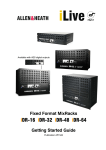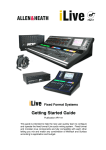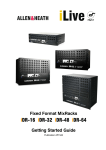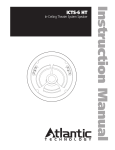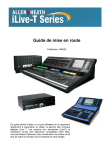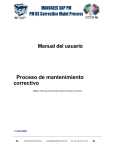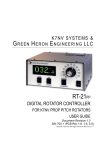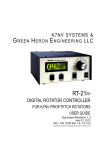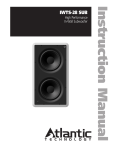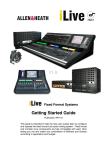Download Atlantic Technology Pattern 200 Instruction manual
Transcript
High Performance Thin Bezel In-Wall Subwoofer Instruction Manual IW-28 SUB 2 Safety Precautions IW-28 SUB In-Wall Subwoofer Table of Contents 2 Model IW-28 SUB 2 Unpacking the Speaker 2Description 3 3 Location Considerations Connection Considerations 4 4 4 5 Speaker Connection Home Theater with a Monoblock Amplifier Connection 2-Channel – Passive Subwoofer Connection Distributed Audio Connection 5 5 6 6 6 Removing and Installing the Grille Treating the Wall Cavity Cutting the Opening Installing the Speaker Assembly Painting the Speaker Assembly 4 Connecting the IW-28 SUB to Your System 5 Mounting the IW-28 SUB 5 Installation of the IW-28 SUB 7 Front Panel Controls 7 7 Low-Pass Control IR Knockout 7Specifications Model IW-28 SUB In-Wall Thin Bezel Subwoofer Thank you for purchasing Atlantic Technology products. Our speaker systems have been designed to deliver exceptional sound and value. We hope you like what you hear, and are happy with your decision to buy them. Please take a few moments to read these instructions. They’re intended not only to tell you how to mount the speaker, but how to get the best performance from it. Unpacking the Speaker Use care when unpacking the speaker. Remember to save all packing materials until you are certain that the speaker has suffered no damage in shipment. If you find such damage, either visible or internal, contact your dealer immediately. If you can do so, save the carton, packing pieces, and plastic bags that came with your speakers. They will be useful in case you move or have to ship your loudspeaker for any reason. Description The IW-28 SUB is a thin bezel, in-wall, passive subwoofer that has dual 8” long throw woofers, a ¾” reinforced MDF baffle and a switchable LowPass crossover that will provide you years of enjoyment. The IW-28 SUB is designed to be used with either a monoblock amplifier, such as our SA-180 in a home theater application or as a passive subwoofer connected in parallel with the L/R speaker in a traditional 2 channel audio system. It may also be used in a distributed audio system to add dynamic range that most people are missing in today’s whole house installations. For Future Reference Record your serial numbers and date of purchase here: Model Number Serial Number Date of Purchase The serial number is found on the back panel. Copyright © 2014 Atlantic Technology International. Specifications are those in effect at the time of printing. Atlantic Technology reserves the right to change specifications or designs at any time without notice. 3 Speaker Placement Instruction Manual Location Considerations Choosing the location for the subwoofer is a very important consideration. Since the IW-28 SUB can't easily be moved once it’s installed (!), very careful consideration should be given to its placement. In general, the cleanest and most articulate delivery of bass energy into the room occurs when the subwoofer is placed asymmetrically with respect to the room’s dimensions and is located along the same wall as the left and right speakers. If this is not possible, try to locate it within the front half of the room. (see fig. 1). Such placement generally results in the best overall balance of bass impact vs.‘one-note boom.’ If you are using two IW-28 SUB modules, follow the same advice: locate them asymmetrically within the room and asymmetrically with regard to each other (i.e. one near a corner, one towards the middle of a wall) to smooth out the bass and minimize random standing wave patterns. (see fig. 2) Figure 2 – Dual Sub Placement FRONT 14' 5' Figure 1 – Asymmetrical Placement FRONT Good 5' 18' 13' Good Good 18' 13' 3' 11' Connection Considerations Choosing how you connect the IW-28 SUB is dependent upon your application. In a Home Theater it should be powered by an external monoblock amplifier, such as Atlantic Technology’s SA-180 with its EQ circuit that was specifically designed to get the very best performance out of the IW-28 SUB. In a traditional 2 Channel System it may be used as a passive subwoofer if your receiver does not have “sub out” and/or an additional monoblock amplifier is not desired. In a Distributed Audio system it can be used either way depending upon your system. We will cover each of these applications separately. 4 Connections IW-28 SUB In-Wall Subwoofer Connecting the IW-28 SUB to Your System WARNING: To prevent risk of electrical shock or damage to your equipment, always switch off the amplifier or receiver when making any system connections. Speaker Connection It’s important to observe polarity while making speaker connections: red (+) terminals on the amplifier to red (+) on the speaker, black (–) on the amplifier to black (–) on the speaker. Look carefully at the wires you are using and note that one of the conductors of each pair will typically be identified by either color, printing on the outer jacket, ridges on the outer jacket, or a thread intertwined with the wire strands. By convention, the marked wire is connected to the red (+) terminal. We recommend that you connect your speakers using high quality dual conductor stranded wire of 16 gauge or heavier, for lengths up to 25 feet (8m). Remember, the lower the gauge number, the heavier the wire. Use heavier gauge wire for longer runs. Please contact your audio/video dealer or installer for specific cable recommendations and further information regarding special circumstances. The terminals themselves are designed to allow the use of very heavy speaker wire or connectors. Strip about ½" (13 mm) of insulation from the connecting wires. Connect them to the appropriate push terminal, being careful to observe polarity (positive to the red terminal, negative to the black terminal). 2 Channel – Passive Subwoofer Connection Remove the jumpers from the IW-28 SUB’s terminals (see fig. 4). Run speaker wires from the receiver’s left speaker terminals to one set of terminals on the IW-28 SUB. Run another set from the receiver’s right speaker terminals to the other set of terminals on the IW-28 SUB. (see fig. 5) It does not matter which set of terminal on the IW-28 SUB is considered ‘right’ or ‘left’. Be careful to observe consistent polarity with all the speakers. All reds and blacks should be consistent. Figure 4 – Removing the IW-28 SUB jumpers Figure 5 – Connecting as a Passive Bass Module WARNING: Before turning on the amplifier, be certain that no stray wire strands are touching across any terminals as this might damage your amplifier. Home Theater with a Monoblock Amplifier Connection Leaving the jumpers in place, connect the speaker wires from the Monoblock amplifier to one black terminal and one red terminal on the IW-28 SUB. (see fig 3) Figure 3 – IW-28 SUB jumpers + – LEFT IMPORTANT! Set the IW-28 SUB’s front-panel Low-Pass switch to the “off” position. This will bypass its crossover. + – RIGHT IMPORTANT! Set the IW-28 SUB’s front-panel Low-Pass switch to the “on” position. This will filter out any signals above 200 Hz from reaching the IW-28 SUB module. IMPORTANT NOTE: Each individual woofer in the IW-28 SUB is 8 ohms; when connecting them in parallel with your front L/R speakers (as you do when using the IW-28 SUB passively), the front L/R speakers should also be 8 ohms minimum, so that their combined paralleled impedance does not fall below 4 ohms. Consult your receiver’s instruction manual for more information on its impedance drive capability. Installation Instruction Manual Distributed Audio Connection How to install the IW-28 SUB with a distributed audio system is dependent upon your specific system. If your source has “sub out connection” follow the “monoblock amplifier connection” instructions. You may use a channel from your amplifier to power the subwoofer or Atlantic Technology’s SA-180 monoblock amplifier. IMPORTANT! Set the IW-28 SUB’s front-panel Low-Pass switch to the “off” position. This will bypass its crossover. Alternately, remove the jumpers from the IW-28 SUB’s terminals (see fig. 4). Run speaker wires from the amplifier’s left speaker terminals to one set of terminals on the IW28 SUB. Run another set from the amplifier’s right speaker terminals to the other set of terminals on the IW-28 SUB. (see fig. 5) It does not matter which set of terminal on the IW-28 SUB is considered ‘right’ or ‘left’. Be careful to observe consistent polarity. All reds and blacks should be consistent. IMPORTANT! Set the IW-28 SUB’s front-panel Low-Pass switch to the “on” position. This will filter out any signals above 200 Hz from reaching the IW-28 SUB module. IMPORTANT NOTE: Each individual woofer in the IW-28 SUB is 8 ohms. Consult your amplifier’s instruction manual for more information on its impedance drive capability. Mounting the IW-28 SUB NOTE: We recommend a professional be involved in the installation of In-wall speakers, if at all possible. The IW-28 SUB woofer module can be easily mounted in most any standard wall material, from ½ to 1½ inches thick. Its rotating wall clamps (sometimes called “dog legs”) firmly fix it to the wall surface after the proper cutout has been made. IMPORTANT! Keep the sides of the mounting hole at least 1½ inches away from beams or studs to ensure that the clamps have adequate room to rotate into position. A stud or other obstruction that’s too close will stop them from properly doing their job. 5 Installation of the IW-28 SUB Removing and Installing the Grille Remove the grille from the speaker using the enclosed tool, an awl or the point of a drywall screw in a grille opening near one of the grille corners. Slowly pry the grille away from the frame, being careful not to damage the speaker’s frame or its finish. To re-install the grille later, press it carefully into position, over the frame assembly. The grille is secured by magnets in the frame and fits snugly. Please take your time and use care when installing the grille. Treating the Wall Cavity The IW-28 SUB does not require a back-box. It is designed to work properly in a standard full-sized wall cavity. This is commonly called an “infinite baffle” installation. However even though there is no back-box, you should exercise good acoustic/mechanical common sense, and prepare the wall cavity as follows: • Make sure there are no extraneous house electrical wires, plumbing, junction boxes, or other loose items that could rattle or vibrate from the IW-28 SUB’s output. Seal all the holes in the cavity with flexible caulking. A subwoofer moves a considerable amount of air, and if something can rattle, it probably will rattle. It’s much, much easier to ‘button everything down’ securely before you install the sub then it is to try to hunt down an intrusive buzz or rattle later on. • Seal all the stud-to-drywall seams with a flexible silicone construction caulk. This will help keep the drywall itself from flexing and rattling against the studs, and it helps form a more airtight “enclosure” for the IW-28 SUB. • Fill the wall cavity loosely with acoustic speaker stuffing (“polyfill” or unfaced fiberglass insulation). Do not pack the stuffing in the cavity tightly, as that will reduce the bass output. 6 Installation IW-28 SUB In-Wall Subwoofer Installing the Speaker Assembly • If this is new construction, we strongly recommend using 5⁄8” or ¾” drywall. It’s heavier and more expensive than ½” material, but it’s far, far superior in terms of acoustic/mechanical integrity and rigidity. We also strongly recommend that the drywall be screwed to the studs every 6 inches or so, instead of the more common practice of nailing it every 12-18”. Use screws for at least a full stud bay on either side of where the IW-28 SUB will be mounted. Cutting the Opening 20 3⁄8” (518mm) 11 1⁄8” (283mm) IW-30 LCR & IW-28 IWTS-30 LCRSUB Mounting Mounting Template Template Mount frame as shown, with IR knockout in upper-right corner. Remove scrim before painting grille. After determining the best location for the speaker as outlined earlier, use a level with the template to mark out the hole. Then using care, cut the proper size hole. (11 1/8” x 20 3/8”) WARNING: Exercise extreme care before making any wall cuts to ensure that you will not cut through any wires, pipes, or other items that may be in the wall. You may sometimes, but not always, be able to determine the approximate location of wires and pipes by looking at the locations of nearby outlets and plumbing. But their location or absence is never an assurance that there is not something within the wall cavity. The clamping mechanism accommodates wall material from ½ to 1½ inches (13 to 38 mm) in thickness. There must be a minimum depth behind the wall face of 3-5⁄8” (92 mm). As noted earlier, be sure to keep the edges of the cutout at least 1½ inches (38mm) away from any stud or obstruction, as the rotating clamps will not operate properly if you don’t. There are holes in the baffle providing access to the rotating clamp screws (See fig left). There is no need to disassemble the speaker for installation. Insert the speaker assembly into the cutout and using a level carefully align the speaker so it is level. Loosen the mounting screws ½ turn, then tighten them, which will cause the attached clamps to unlock, rotate and position themselves properly behind the wall. Continue to tighten until the frame is snug in the wall.You want the bezel to conform to the wall surface, and the frame not to rattle from the speaker’s vibration, but be very careful not to over tighten the screws. Painting the Speaker Assembly The white plastic frame and metal grille may be left as is, or painted to match your décor.You can paint the frame before or after it is installed in the wall.You will need to remove the baffle from the frame before painting. Spray painting (using slightly thinned paint) is the best method to use for painting the grille. Be sure to remove the scrim cloth before painting the grille. Start at one corner and gently peel the scrim from the grill. After painting the grille, use air pressure to “blow out” any grille holes that are filled in with paint. When the grille is dry, re-apply the scrim cloth. You may need to use a light coat of low tack spray adhesive to hold the scrim in place. Specifications Instruction Manual Front Panel Controls Low-Pass Control The IW-28 SUB has a front-mounted control that selects or bypasses the speaker’s built-in Low-Pass crossover. Set this to the “off” position when connected to the SA-180 or other amplifier. In this case, the receiver is used to control the low pass filtering. Set it to “on” only when using it in the “passive” mode, powered by 2 channels of amplification. IR Knockout There is an IR “knockout” plug in the upper right corner of the baffle behind the logo. If you need, you can install a standard IR receiver in the knockout hole. Should you have any questions or problems please contact us at 781-7626300 or through our web site, www.atlantictechnology.com. 7 Specifications IW-28 SUB Overall Dimensions (W x H x D) 12 5⁄8 x 217⁄8 x 3 7⁄8" (319 x 554 x 100mm) Cut-out Dimensions (W x H) 111⁄8 x 20 3⁄8” (283 x 518mm) Drivers/Design Dual 8” (203mm) long-throw, 40mm voice coils Frequency Response 38-200 Hz +/- 3dB, passive response Recommended Amplifier Power 30-200 Watts RMS Low-pass Filter Frequency 200 Hz Sensitivity 89dB Impedance Each individual woofer 8 ohm; paralleled 4 ohms IMPORTANT NOTE: The power recommendation for this speaker assumes that you will not operate your amplifier/receiver in a way that produces distortion. Even rugged speakers like ours can be damaged by an amplifier driven into audible distortion. The harsh amplifier distortion (“clipping”) that occurs in this situation will eventually cause damage to the speaker system. This type of damage may be cumulative and can build up over time, as the amplifier is driven into overload again and again. Such damage is easily identifiable through examination of the damaged speaker’s voice coil and is not covered by the warranty. Specifications are those in effect at the time of printing. As part of our ongoing program of continuous product improvement, Atlantic Technology reserves the right to change specifications or appearance at any time without notice or obligation to modify existing product.. Warranty First, we’d like to thank you for purchasing an Atlantic Technology product. We wish you many years of enjoyment and satisfaction from it. Second, be aware that you don’t have to send in any Warranty card to be covered by the Limited Warranty. All you need to do is keep your original Invoice or Bill of Sale for proof of purchase, meet the stated requirements, and follow the instructions listed within that Warranty. Please attach your Original Invoice or Bill of Sale to this manual as proof of purchase and keep them in a safe place. VERY IMPORTANT NOTE: PLEASE NOTE THAT ATLANTIC TECHNOLOGY PRODUCTS CARRY ONLY A 90 DAY LIMITED WARRANTY. YOU MUST MEET ALL THE BELOW REQUIREMENTS AND REGISTER ONLINE IN ORDER TO BE COVERED BY THE FREE EXTENDED SERVICE AGREEMENT TO ASSURE EXTENDED FREE PROTECTION!! Free Extended Service Agreement Atlantic Technology offers a free Extended Service Agreement that provides enhanced protection against product defects. In order to qualify for the free Extended Service Agreement you must: 1. Have purchased your Atlantic Technology products from an Authorized Atlantic Technology Reseller or Installer. 2. Go to www.atlantictechnology.com and click on Support>Register Your Warranty. Fill out the required information. Be sure to have your home address, name, address and invoice from the business you purchased, and the serial numbers of all Atlantic Technology products purchased. THIS MUST BE DONE WITHIN 30 DAYS OF PURCHASE. 3. If you purchased multiple Atlantic Technology products you will be able to enter them all using one online form. Model and Serial numbers can be found on the back of each unit and on the outside of their respective boxes. Once all the criteria have been met, you qualify for a free Extended Service Agreement that entitles you to additional coverage against defects in workmanship and manufacturing for a period of up to 5 years on passive speakers and up to 1 year on powered speakers (including subwoofers). This coverage is in addition to the 90 Day Limited Warranty included with all Atlantic Technology products. If you are not able to register your product using the internet, please call customer service at 781.762.6300. Limited Warranty Statement of Warranty: Atlantic Technology International Corp. warrants Atlantic Technology Products to be free from defects in material and workmanship for 90 days from the time of original purchase. This Warranty covers the original retail purchaser of this product only and is valid only in the Continental United States, Alaska, and Hawaii and all US Possessions. To obtain Warranty service: Please contact your local Atlantic Technology reseller to determine if they are an Authorized Repair Center for Atlantic Technology products.You will need your original Invoice or Bill of Sale to prove Warranty eligibility. If your local dealer is not an Authorized Warranty Center you may contact us at 781-762-6300 for further help or to send the product back to us for service and repair.You must first get a Return Authorization Number from us to ship the product back, so it is imperative that you call us first. What we are responsible for: We will pay for all labor and parts for covered items. If the repairs are eligible for coverage under the terms of this Warranty we will also pay for return shipping charges to you. What you are responsible for: You must pack the product properly for safe shipping to your Authorized Dealer or us. You are responsible to pay for all packing, shipping, and insurance costs to get the unit(s) back to Atlantic Technology or your Authorized Dealer. Optional replacement: We, at our option, may replace rather than repair your Atlantic Technology product with a new or reconditioned one of the same or similar design. The repair or replacement will be warranted for 90 days from date of receipt back to you. All details in terms of eligibility for an Extended Service Agreement will carry over from the original purchase to the replacement item. What this Warranty does not cover: This Warranty does not cover defects resulting from accidents, damage while in transit, alterations, unauthorized repair, failure to follow instructions, misuse, fire, flood, and Acts of God. This Warranty will be void if the product’s serial number has been altered or removed or if the product has been modified or defaced. Exclusions and Limitations: Implied warranties, including those of fitness for a particular purpose and merchantability (an unwritten warranty that the product is fit for ordinary use) are limited to the period of any Warranty granted hereby. We will not pay for loss of time, inconvenience, loss of use, or property damage caused by your Atlantic Technology product or its failure to work, or any other incidental or consequential damages. State law rights: Some states do not allow the exclusion or limitation of incidental or consequential damages, so the above limitation or exclusion may not apply to you. This Warranty gives you specific legal rights, and you may have other rights which vary from state to state. This Warranty is valid only when Atlantic Technology products are purchased from an Authorized Atlantic Technology Reseller in the Continental United States, Alaska, and Hawaii and all US Possessions. If you purchase Atlantic Technology products outside the United States please consult your local distributor or reseller for applicable Warranty coverage and restrictions. Should you have any questions or problems please feel free to contact us at 781-762-6300 or through our web site, www.atlantictechnology.com. Extended Service Agreement (only available in the Continental United States,Alaska, and Hawaii and all US Possessions): You must complete the Extended Service Agreement application, and meet all of the purchase criteria stated on that application, to receive an Extended Service Agreement that covers your Atlantic Technology products well beyond the standard 90 day Warranty. 343 Vanderbilt Avenue Norwood, MA 02062 (781) 762-6300 www.atlantictechnology.com 015-1028








